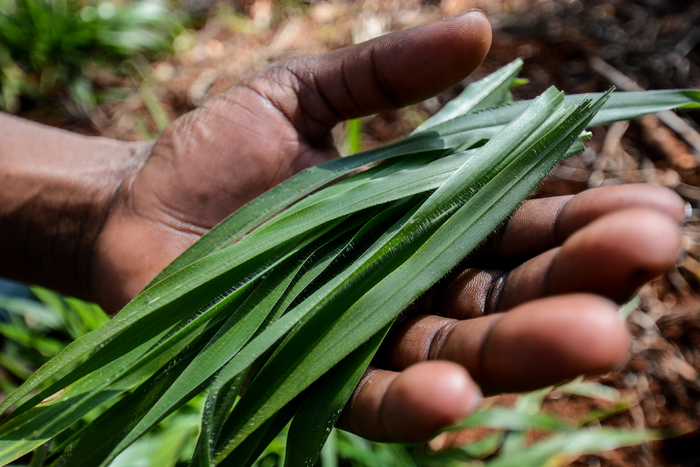Jacobo Arango, an environmental biologist at the Tropical Forages Program at the Alliance of Bioversity and CIAT and an author of the mitigation chapter of the Intergovernmental Panel on Climate Change (IPCC) report released on April 4, 2022, said it was encouraging to see in the report that some countries are on track to meet their commitments. but unfortunately, the world is not on track to meet the 1.5-degree warming scenario.

Credit: CIAT / Georgina Smith
Jacobo Arango, an environmental biologist at the Tropical Forages Program at the Alliance of Bioversity and CIAT and an author of the mitigation chapter of the Intergovernmental Panel on Climate Change (IPCC) report released on April 4, 2022, said it was encouraging to see in the report that some countries are on track to meet their commitments. but unfortunately, the world is not on track to meet the 1.5-degree warming scenario.
“The agriculture and land-use sector (which includes forestry) has a really invigorating role with this IPCC report,” he said. “It’s not enough only to lower emissions, we also need to actively remove carbon from the atmosphere.”
While the popular conception of carbon capture and storage is the injection of carbon dioxide gas deep underground, Arango says that deep-rooted plants, including those used in livestock grazing, could store carbon 2-3 meters underground as soil organic matter (soil carbon).
“If you use the right plants, with a long root system, they can transfer the carbon from the atmosphere into the deep soil layers,” he said, “Instead of big fancy machines taking carbon out of the atmosphere and injecting it into rock formations, agriculture does that naturally with plants, along with higher food production and other environmental benefits, such as water and biodiversity conservation.”
Arango explained that plants usually put carbon in shallow soil layers (the first 30 centimeters). However, this carbon is more susceptible to return back to the atmosphere by the soil respiration process, while soil carbon deposited deeper by long roots has a higher chance to be stored for much longer.
Ngonidzashe Chirinda, an assistant Professor of Sustainable Tropical Agriculture at Morocco’s
Mohammed VI Polytechnic University and former IPCC author, says the 30-centimeter depth used in the IPCC greenhouse gas inventory guidelines underestimates carbon uptake linked to tropical forages that develop roots to over 1 meter in depth.
“Few countries currently report soil carbon’s climate change mitigation contribution in their national greenhouse gas inventories and the lack of accounting means a vital carbon sink is missed,” Chirinda said, adding that countries need to accurately report the carbon added to the soil through mitigation actions such as adopting deep-rooted tropical forages (grasses and other plants grown as food for livestock).
Tropical Forage as Carbon Sinks
Outside of his role with the IPCC, Arango’s work with the Alliance has been studying tropical forages, some of which already have the long roots that deposit carbon meters below the ground.
In one study in Colombia’s Orinoquía basin, his team was able to sample soil carbon down much deeper than 30 centimeters and establish that soil carbon was accumulating there.
The authors of that study hypothesized that the introduction of the tropical grass B. humidicola influenced soil carbon accumulation and soil quality of the improved pasture area probably through its abundant root system and its turnover.
Arango says the key to breeding future varieties of tropical forages with deep roots while still maintaining yields would be the genetic diversity stored in the brand-new Future Seeds genebank at CIAT´s headquarters outside Palmira, Colombia, home to about 68,000 accessions of common beans, tropical forages, and cassava, crops that are a vital source of nourishment and income for millions of smallholder farmers across the globe.
“We’re researching varieties with those long roots that play a role in getting carbon down to those deep soil layers, which can still maintain production for farmers,” Arango said, adding that if farmers in Colombia and other parts of the world can be provided with better forages, they would be able to offset the carbon produced by their cattle.
“If we find alternatives to establish livestock production systems that are net-zero or even negative in emissions, they could even sell carbon credits, opening up a new income source for these farmers by participating in the global carbon market.”
Chirinda explained there are many other examples of agricultural practices that either increase carbon uptake or reduce its loss.
“There’s agroforestry (growing crops and trees on the same land), silvopastoral systems (including trees in grasslands), reduced or no soil tillage (avoiding soil disturbance), and having soil covered most of the year through practices such as relay and cover cropping,” Chirinda said.
Method of Research
Systematic review
Subject of Research
Not applicable
Article Title
Sixth Assessment Report, Climate Change 2022: Mitigation of Climate Change
Article Publication Date
4-Apr-2022




